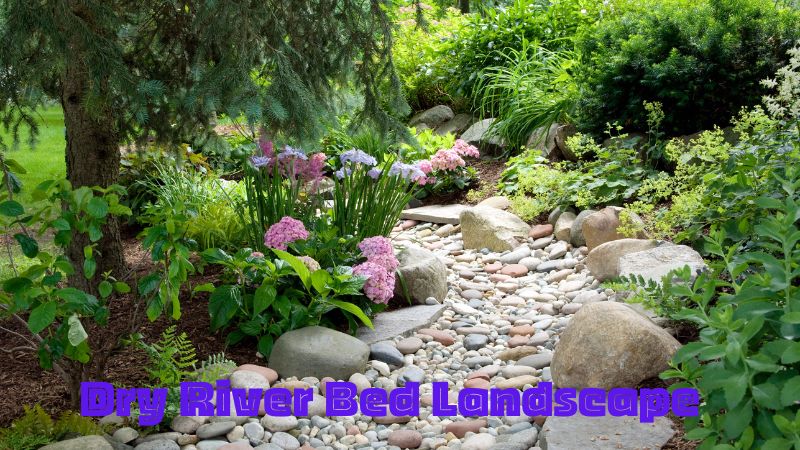The dry river bed landscape is a harmonious combination of natural elements such as rocks, plants, and water, creating a peaceful and relaxing space. In this article, Garden Creatives will guide you step by step to create the perfect dry stream bed, from planning and choosing materials to planting and adding decorative details. Let’s explore how to turn your backyard into a small paradise with a beautiful dry stream bed.
Landscape a dry river bed landscape in the yard
Preparing instruments
Landscape mulch (to prevent weeds)
Slate
River rocks
Shovel
Pipe (for marking shapes)
Plant materials: immortelle, succulent, silver plant, lily of the valley
Statue
Implementation steps
Step 1: Dig out the weeds
When we started renovating the yard, we left a small patch of grass behind. The arbor will surround our dry stream bed.
After completing the backyard rock installation, the lone patch of grass in the back left corner stuck out like a sore thumb. It doesn’t make sense to have to take the lawn mower out every week to mow such a small area; Not to mention moving the machine across our yard was very difficult! More importantly, not using electricity to mow the lawn or water to keep the grass green is sustainable.
The best solution is to install a dry stream bed and rock garden to replace the grass. There’s nothing better than putting your sweat and effort into building a sustainable garden with beautiful results like this!
Step 2: Pre-planning work
First, we weeded the area intended to make the stream bed dry. To outline the shape of the dry stream bed, we used a garden hose to draw the outline. Then we started digging the grass. Because we worked late into the night, we don’t have actual pictures of the dry stream bed excavation process, but you can see its shape in the diagram above. Note that we sloped the sides and dug a shallow bottom so we wouldn’t have to fill in too much rock.
Next, we dug a large hole to plant the gorgeous little Blue Danube juniper pom pom at the south end of the dry stream bed.
When my husband dug this hole, we no longer had a clean container to dump the soil into. So he used some leftover soil bags and filled them up. He then placed the bags in front of the house and the neighbors took them all. No waste, no shortage!
The shape of this furball is just right to fit into a statue.
Step 3: Keep weeds at bay
After planting the juniper, we added landscape fabric along the bottom of the bed and up the sides to prevent weeds from growing. We extended the landscape fabric a few feet beyond the edges, so we could spread it under the larger rocks we planned to place around the bed (which you’ll see in the next step). In areas where boulders are not planned along the sides, we fold up landscape fabric and stick stakes into the sides of the dry stream bed to hold it in place.
Once the landscape fabric was in place, we began filling in the dry stream bottom with a variety of smooth, colorful river rocks. We laid rocks around the pom juniper and along the edge of the pond, creating a sturdy and attractive base, preventing weeds from growing, and keeping the garden clean.
Step 4: Place stepping stones
Stepping stones not only shape the dry stream bed but also provide a convenient walkway and a platform for training the silver lace vines as they grow larger.
We hand-picked the pieces of stone at the stone yard that we thought were most suitable. When purchasing slate, bring a sketch of your plan to help visualize the space.
In addition, we purchased some large decorative rocks for the rock garden and a few extra rocks to place around the dry stream bed. When we brought the stones home, we were excited to set them on site to see the results of our choice.
You can see where the landscape fabric stretched over the edge of the dry stream bed and was held in place by some pieces of slate. Finally, we will use this ‘buttress’ as a base to level one side of a wooden bridge over a dry stream bed. We haven’t built the bridge yet, but Rome wasn’t built in a day!
You can fill the gaps with gravel, but we chose to fill them with soil so we could grow moss between and around the stones.
Take the time to dry arrange stepping stones and large rocks to ensure they are both beautiful and functional.
Once happy with the placement, we used an edging tool to dig around each stone, removing grass and a few inches of topsoil. The goal is to insert the stones slightly below the surface to keep them in place and prevent them from shifting in cold weather.
Step 5: Add river rocks
Next, it’s time to refine the details and get into the dirt! I actually sat down on the dry stream bed and pushed all the river rocks out and over the edge of the landscape fabric to hide them.
I keep a bucket of river ice that my husband constantly refills for me, in case I need more. I carefully work around the entire perimeter of the stream bed: the process is slow but truly transforms the dry stream bed from a hole in the ground into a natural landscape as it has existed for a long time.
Step 6: Place the statue – Happy/sad face
Where the dry river bed landscape, we found the perfect statue to highlight the pom pom juniper tree. We pulled river rocks from the dry stream bed around the decorative juniper tree and placed it in front of the statue, ending up next to a pond we installed when we built the stone terrace.
The statue represents the mask of tragedy and comedy and is a great reminder of all the hard work with its failures, funny moments, and cold cereal dinners. But we wouldn’t trade building our garden from scratch for anything! It is our refuge.
Step 7: Plant trees around the dry stream bed
A great tip for planting your entire backyard is to buy planting materials in the fall. They’re all on sale, and you can plant for a fraction of the cost at the beginning of the season.
After completing all the details on the dry stream bed, we planted trees around it.
Moss eventually grows to fill the spaces between the stones. However, it doesn’t grow near the silver lace vines so we filled that area with wood chips, which helps minimize weeds.
Around some rocks on the perimeter of the dry stream bed, we planted miniature Stella D’oro lilies. These plants grow to about 10-12 inches and spread up to two feet. We only need four plants to bloom from May to August, creating beauty along the edge of a dry stream bed. Even when not in bloom, they still look stunning.
Around the rocks we planted drought-tolerant ground covers like sedum and some hardy succulents. These plants will reseed each year, even after harsh winters.
Conclude
Landscaping a dry river bed landscape not only brings natural beauty but also makes your yard unique and impressive. Through careful planning and step-by-step implementation, you can create a green, peaceful, and sustainable space. Dry river bed landscape are not only an aesthetic highlight but also an effective solution for water and weed control.





